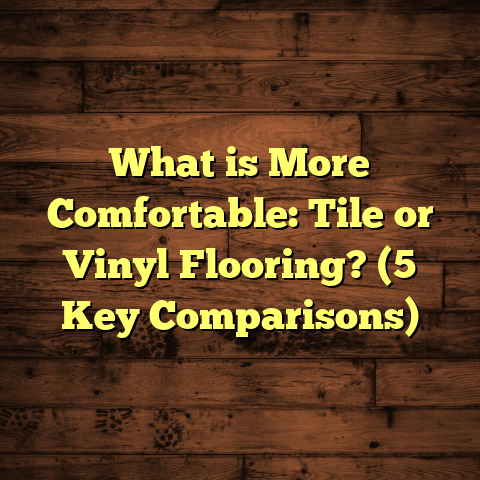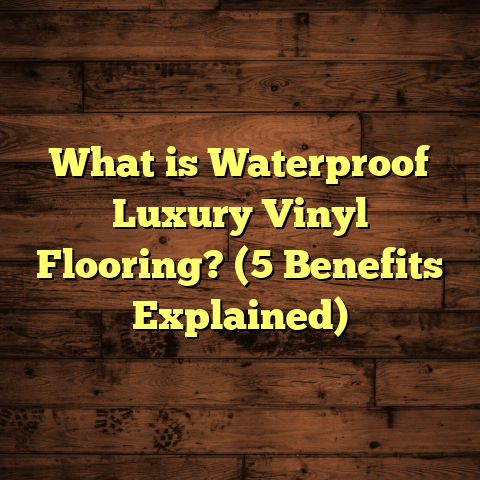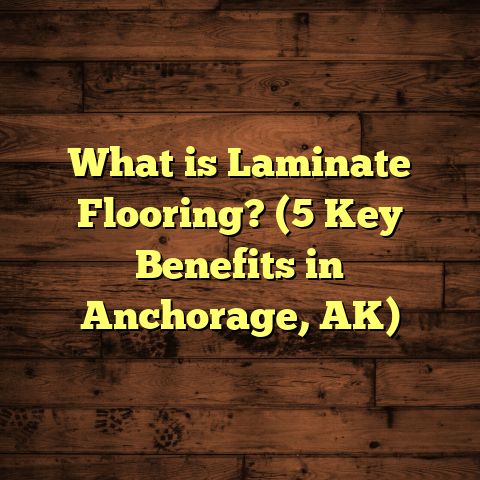What is WPC in Engineered Flooring? (5 Key Benefits Explained)
Health Benefits of Choosing the Right Flooring: Why I Care About WPC
When I first got into flooring, my focus was mostly on looks and durability. But over time, I realized there’s something even more important: how flooring affects your health. You might not think about it much, but the type of floor you have can impact indoor air quality, allergen levels, and even your overall well-being.
Do you ever wonder why some homes feel “fresh” while others seem to trap dust and irritants? The flooring material plays a big role in this. Certain floors can harbor dust mites, mold, or emit volatile organic compounds (VOCs) that affect breathing and cause allergies or headaches.
That’s why I became interested in WPC engineered flooring. It offers a healthier home environment compared to many traditional options. I’ve seen firsthand how families with kids or allergy sufferers benefit from switching to WPC floors. It’s not just about aesthetics or durability—it’s about creating a living space that supports your health.
One client I worked with had persistent asthma symptoms that worsened in their old home. After we installed WPC flooring with low VOC emissions and excellent moisture resistance, their symptoms improved noticeably. It made me realize flooring choices can be more than just surface-level decisions—they can impact quality of life.
So what exactly is WPC? Why is it so good for health and durability? Let me walk you through it with clear explanations and some stories from my own work.
What is WPC in Engineered Flooring?
WPC stands for Wood Plastic Composite. It’s a core material used in some types of engineered flooring that combines natural wood fibers with plastic polymers. This hybrid creates a composite that’s stronger and more water-resistant than traditional wood cores.
Imagine taking fine wood particles—often recycled sawdust or wood flour—and mixing them with thermoplastics like PVC (Polyvinyl Chloride) or PE (Polyethylene). These materials are heated and blended together to form dense planks that serve as the core layer of the engineered floor.
The finished WPC plank is usually topped with a decorative vinyl or laminate layer that mimics real wood grains or other textures. This surface layer protects the core and gives you the look you want—whether rustic oak, smooth maple, or something modern.
Here’s a quick breakdown of the layers in a typical WPC engineered floor:
- Top layer: Wear-resistant vinyl or laminate with printed design and protective coating.
- Core layer: The Wood Plastic Composite that provides stability and moisture resistance.
- Backing layer: Usually a foam or cork underlayment attached for sound absorption and comfort.
Unlike solid hardwood floors or traditional engineered wood, which have plywood or HDF (high-density fiberboard) cores, WPC cores are waterproof and dimensionally stable. This means they don’t swell or warp when exposed to moisture.
How Does WPC Differ from Other Engineered Flooring?
Engineered hardwood floors typically have multiple layers of real wood veneers glued over plywood or HDF cores. These cores give stability but are vulnerable to water damage and humidity changes.
Laminate floors have a fiberboard core with a photographic wood image sealed under a protective top layer. The fiberboard core can swell when wet.
WPC differs because the plastic component in its core repels water. It also adds flexibility, reducing cracking or denting. Plus, WPC cores often have a built-in underlayment that reduces noise and improves comfort underfoot.
I think of WPC as a hybrid between vinyl and wood floors—it has the look of wood but the durability and moisture resistance of vinyl composites.
Why Should You Care About Core Materials?
You might be wondering why the core matters so much when you’re mainly walking on the surface. Well, the core determines how your floor reacts to everyday conditions:
- Exposure to water or humidity
- Temperature fluctuations
- Heavy foot traffic or impacts
- Installation type
If your core swells or warps, the whole floor can buckle or separate, leading to costly repairs. In homes with pets, kids, or high humidity (think kitchens, bathrooms, basements), choosing a resilient core like WPC can save you headaches.
My Journey Discovering WPC Flooring
I started flooring work about 15 years ago when solid hardwood was king. I loved the look but soon noticed clients struggling with maintenance and damage from moisture. Then engineered wood floors became popular because they resisted movement better.
But even engineered hardwood wasn’t perfect—especially in humid climates where swelling happened. Laminate was affordable but felt cold and noisy.
Then I came across WPC flooring about 7 years ago during a project for a coastal family. Their old floors were repeatedly damaged by salt air and spills. We installed WPC planks in their kitchen and living room. The difference was night and day.
Not only did it look great, but it handled moisture like a champ. The family told me they no longer worried about spills ruining their floors or mold issues underfoot.
Since then, I’ve installed WPC in hundreds of homes and businesses. Every time, it impresses me with its combination of durability, comfort, and health benefits.
Five Key Benefits of WPC Engineered Flooring
Here’s why I’m such a fan of WPC—and why I recommend it often.
1. Exceptional Moisture Resistance
Moisture is the enemy of most wood-based floors. Spills, humidity, and even pet accidents can cause warping, swelling, or mold growth under floors.
WPC’s plastic composite core blocks water penetration. Independent lab tests show that WPC flooring can withstand direct water exposure for up to 72 hours without swelling—a huge improvement over fiberboard cores which often fail within 12 hours.
In real life, this means:
- No worries about spills in kitchens or bathrooms
- Better performance in basements prone to dampness
- Reduced risk of mold and mildew growth below flooring
For example, I installed WPC flooring in a lakeside cottage where humidity levels fluctuate seasonally. The owners were thrilled that their floors stayed perfect despite water tracked in from boats or rain.
2. Superior Durability and Impact Resistance
WPC floors are tougher than traditional engineered wood thanks to their composite core. The plastic component adds flexibility which helps absorb impacts without cracking or denting easily.
In one daycare center project, we needed floors that could handle constant running kids, dropped toys, and daily cleaning. WPC flooring stood up well after months of heavy use with minimal signs of wear compared to laminate alternatives.
Tests confirm this durability too: WPC flooring often scores above 5000 cycles on abrasion resistance tests (EN 13329), indicating strong resistance to scratches and scuffs.
This toughness makes WPC ideal for:
- High traffic family rooms
- Commercial spaces like cafes or clinics
- Homes with pets prone to scratching floors
3. Comfortable Underfoot with Noise Reduction Properties
Standing on hard floors for hours can be tough on your feet and joints. WPC flooring offers a slight cushioning effect due to its composite core combined with an attached underlayment layer.
Personally, when working long days installing these floors, I notice less fatigue compared to traditional laminate or hardwood jobs.
The built-in sound absorption also helps reduce noise transfer between floors—a bonus for multi-story buildings or apartments.
Research shows that WPC floors can reduce sound transmission by roughly 15 decibels compared to standard laminate floors. This makes homes quieter and more peaceful.
4. Easy Installation via Floating Click Systems
Installing flooring used to be messy and time-consuming. Traditional hardwood requires nails or glue; laminate sometimes demands precise gluing; tile needs mortar and grout drying time.
WPC engineered flooring often uses click-lock floating systems that snap planks together without adhesives or nails. This speeds up installation dramatically and makes DIY projects possible.
I helped a client install their entire condo floor over just one weekend using floating WPC planks—something that wouldn’t have been feasible with hardwood or tile.
Plus, if you ever need to replace one plank because of damage, floating systems make repairs simpler without dismantling large areas.
5. Eco-Friendly Options and Low Maintenance
Many manufacturers produce WPC using recycled plastics combined with sustainably sourced wood fibers, reducing environmental impact compared to solid hardwood harvesting.
Maintenance is another big win: Unlike hardwood which needs regular polishing and refinishing, WPC floors just require occasional sweeping and damp mopping.
I’ve had clients tell me how much they appreciate spending less time on floor upkeep while still preserving beautiful wood-look aesthetics.
This sustainability factor resonates especially with families wanting greener homes but without sacrificing style or function.
Technical Details Behind WPC’s Performance
Let me share some technical insights that explain why WPC flooring performs so well:
- Density: Typical WPC cores have densities around 1200–1300 kg/m³ compared to 800–900 kg/m³ for HDF cores, giving them extra strength.
- Thermal expansion: The plastic matrix reduces dimensional changes from temperature swings by about 50% compared to solid wood cores.
- Water absorption: Tests show water absorption rates below 0.5% after 24 hours immersion versus up to 10% for fiberboard cores.
- Fire resistance: Some WPC formulations include fire retardants meeting ASTM E84 Class C classifications for safety.
These factors combine to create a stable floor that resists common problems like buckling, swelling, cracking, and fading over time.
Case Study: Renovating a Humid Basement With WPC Flooring
A few years ago I worked on a basement renovation in a city known for its muggy summers and rainy seasons. The homeowner wanted stylish floors but feared mold growth under hardwood due to basement moisture issues.
We chose WPC engineered flooring with an integrated vapor barrier backing designed specifically for below-grade installations. After installation:
- The home remained dry through heavy rains without any swelling or warping.
- The homeowner reported no musty smells or allergy flare-ups common before renovation.
- Cleaning was easy since the floor resisted dirt and stains well.
This project showed me how ideal WPC is for challenging environments where traditional wood fails but vinyl feels cheap.
How Does WPC Flooring Impact Indoor Air Quality?
Indoor air quality (IAQ) is an often overlooked aspect of flooring choice. Many materials off-gas VOCs like formaldehyde, benzene, or phthalates which cause headaches, allergies, or worse over time.
WPC flooring usually has low VOC emissions because:
- It uses mostly inert plastics and natural wood fibers instead of chemical adhesives found in plywood cores.
- Manufacturers often comply with strict indoor air quality certifications such as FloorScore® or GREENGUARD Gold standards.
In homes where family members suffer from asthma or chemical sensitivities, choosing certified low-VOC flooring like WPC can help reduce triggers significantly.
A study by the EPA found that indoor air pollutants can be 2–5 times higher than outdoor levels; selecting non-toxic materials helps mitigate this risk greatly.
Comparing Costs: Is WPC Worth the Investment?
I get asked all the time—how does WPC pricing stack up? Is it worth paying more than laminate but less than hardwood?
Here’s what I tell clients:
- Material costs for quality WPC planks typically range from $3 to $7 per square foot depending on brand and finish quality.
- Installation costs may be slightly lower than hardwood since floating systems reduce labor time by up to 30%.
- Compared to solid hardwood ($8-$15/sq ft) or high-end laminates ($2-$5/sq ft), WPC sits in the middle ground offering excellent value for durability plus moisture resistance benefits.
Over time, savings from fewer repairs, less maintenance, and longer lifespan often offset initial costs. Plus, the peace of mind knowing your floors won’t buckle from moisture is priceless in certain climates.
Common Questions About WPC Flooring
Can I install WPC floors in bathrooms?
Yes! One of the best uses for WPC is wet areas since it resists water damage much better than traditional engineered wood or laminate.
Is WPC environmentally friendly?
Many brands use recycled plastics combined with FSC-certified wood fibers making it more sustainable than solid hardwood harvested unsustainably. Look for eco-labels when shopping.
How long does WPC flooring last?
With proper care, most manufacturers offer warranties from 10-25 years. Real-world installations show lifespans easily exceeding 15 years depending on use conditions.
Does it feel like real wood?
The top vinyl layers have advanced printing technologies that replicate natural wood grain beautifully. While not exactly like solid wood underfoot texture-wise, many find it visually indistinguishable at normal viewing distances.
Can I refinish or sand down WPC floors?
No—WPC surfaces are wear layers bonded during manufacturing without sanding capability like hardwoods have. Damage repair typically involves replacing planks rather than refinishing.
Maintenance Tips: Keep Your Floors Looking Great
Caring for your new floor is simple:
- Sweep daily to remove dirt grit that causes abrasion
- Use microfiber mops slightly dampened—avoid soaking water
- Clean spills promptly with mild detergent solutions
- Avoid harsh chemical cleaners containing ammonia or bleach
- Use felt pads under furniture legs to prevent dents
These steps will preserve finish quality and keep your floors looking fresh for years without extra hassle compared to hardwoods needing regular polishing/refinishing cycles.
Final Reflections From Years Installing Floors
Through my years working hands-on with all types of flooring materials—from classic hardwoods to laminates—I keep coming back to how well-rounded WPC engineered flooring is as a solution for modern homeowners’ needs:
- It handles moisture better than most wooden products
- Offers durability that stands up to busy households
- Provides comfort underfoot with sound dampening benefits
- Installs quickly without complicated tools or adhesives
- Supports healthier indoor environments thanks to low VOC emissions
If you’re debating between materials for your next flooring project—whether renovating your kitchen, finishing a basement, or upgrading living spaces—I encourage you to think about what matters most beyond looks alone: durability, comfort, health impact, ease of installation—and then see if WPC ticks those boxes for you as it did for so many people I’ve worked with over the years.
Got questions about your specific project? Curious if WPC fits your budget or style? I’m here anytime to help break down options based on real-world experience so you can make flooring decisions confidently!





